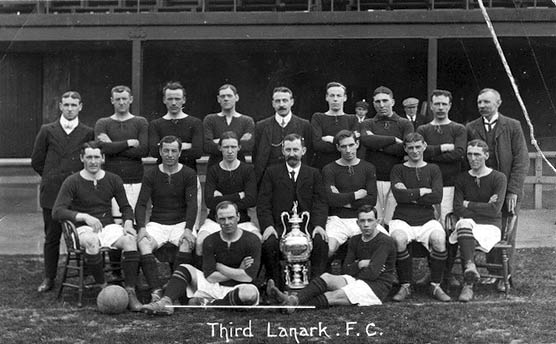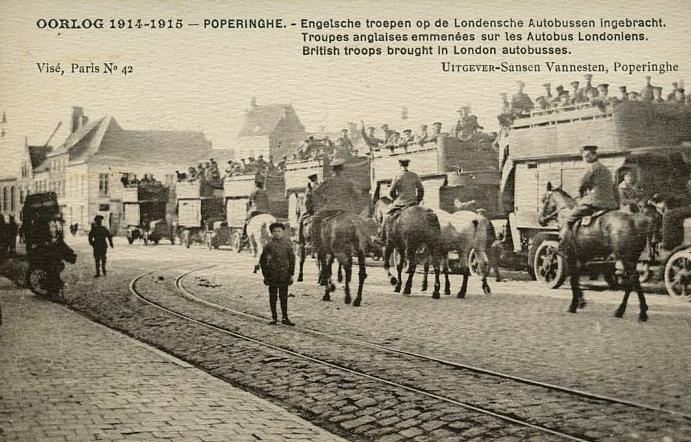|
Donald McLeod (footballer)
Donald McLeod (28 May 1882 – 6 October 1917) was a Scottish professional footballer who made over 260 appearances in the English and Scottish Leagues for Middlesbrough and Celtic respectively. A right back, he was capped by Scotland and represented the Scottish League XI. McLeod was nicknamed 'Slasher'. Personal life Born in Laurieston, McLeod grew up in Grangemouth and Stenhousemuir and was married with three daughters. After his retirement from professional football in 1914, he took over the Lord Byron pub in Middlesbrough. In 1916, two years after the outbreak of the First World War, McLeod was conscripted into the Royal Garrison Artillery. He was subsequently transferred to the Royal Field Artillery and became a gunner. On 5 October 1917, during the Battle of Passchendaele, McLeod was wounded in action, losing his right leg below the knee and part of his left foot. He died of wounds the following day at the 47th Casualty Clearing Station in Dozinghem, near Pope ... [...More Info...] [...Related Items...] OR: [Wikipedia] [Google] [Baidu] |
Laurieston, Falkirk
Laurieston is a village in the Falkirk council area in Central Scotland. It is east Falkirk, south-west of Grangemouth and west of Polmont. Laurieston is located on the A803 road between Falkirk and Polmont. At the time of the 2001 census, Laurieston had a population of 2,752 residents,Insight 2001 Census, No. 3 – 2001 Census population of wards and settlements www.falkirk.gov.uk. Retrieved 2009-12-09 down from 3,000 in 1991 and 3,300 in 1971. The course of the runs through the village with the largest |
Middlesbrough
Middlesbrough ( ) is a town on the southern bank of the River Tees in North Yorkshire, England. It is near the North York Moors national park. It is the namesake and main town of its local borough council area. Until the early 1800s, the area was rural farming land. By 1830, a new industrial town and port started to be developed, driven by the coal and later ironworks. Steel production and ship building began in the late 1800s, remaining associated with the town until post-industrial decline occurred in the late twentieth century. Trade (notably through ports) and digital enterprise sectors contemporarily contribute to the local economy, Teesside University and Middlesbrough College to local education. In 1853, it became a town. The motto ("We shall be" in Latin) was adopted, it reflects ("We have been") of the Bruce clan which were Cleveland's mediaeval lords. The town's coat of arms is three ships representing shipbuilding and maritime trade and an azure (blue) lion, ... [...More Info...] [...Related Items...] OR: [Wikipedia] [Google] [Baidu] |
Glasgow Cup
The Glasgow Cup is a football tournament open to teams from Glasgow, Scotland. Operated by the Glasgow Football Association, it was competed for annually by senior Glasgow clubs from 1887 until 1989. It is now (since the 2019–20 amended rules) competed for between the senior teams of Clyde, Partick Thistle and Queen's Park and the youth teams of Celtic and Rangers, and has used both knockout and round robin formats to determine the finalists. The cup was dominated by the city's Old Firm rivals, Rangers and Celtic, who won the competition 44 times and 29 times respectively (including one shared win) while it was a senior competition. Only five times did the final not feature either Rangers or Celtic (1889, 1915, 1946, 1947, and 1989). The advent of European football led to the Glasgow Cup becoming less valued, and the tournament did not take place at all or was not finished several times in its later years. Since it was reinstated for youth teams, Rangers have won a further ... [...More Info...] [...Related Items...] OR: [Wikipedia] [Google] [Baidu] |
Scottish Football League First Division
The Scottish Football League First Division was the second tier in the Scottish football league system between 1975 and 2013. History The First Division was introduced in 1975–76 to replace the old Scottish Football League Division Two, as the top flight of the Scottish Football League was renamed from Division One to Premier Division. In 1998, the Premier Division clubs broke away from the Scottish Football League to form the Scottish Premier League. The First Division remained the second tier of the Scottish league system, but was now the top tier of the Scottish Football League. In July 2013, the Scottish Football League and Scottish Premier League merged to form the Scottish Professional Football League (SPFL). The SPFL named its second tier as the Scottish Championship, which effectively replaced the First Division. Competition From 1994 until 2013, the First Division consisted of ten teams. From 1998, only the winner of the First Division was promoted to the Scottish ... [...More Info...] [...Related Items...] OR: [Wikipedia] [Google] [Baidu] |
1902-03 Celtic F
Nineteen or 19 may refer to: * 19 (number), the natural number following 18 and preceding 20 * one of the years 19 BC, AD 19, 1919, 2019 Films * ''19'' (film), a 2001 Japanese film * ''Nineteen'' (film), a 1987 science fiction film Music * 19 (band), a Japanese pop music duo Albums * ''19'' (Adele album), 2008 * ''19'', a 2003 album by Alsou * ''19'', a 2006 album by Evan Yo * ''19'', a 2018 album by MHD * ''19'', one half of the double album '' 63/19'' by Kool A.D. * '' Number Nineteen'', a 1971 album by American jazz pianist Mal Waldron * ''XIX'' (EP), a 2019 EP by 1the9 Songs * "19" (song), a 1985 song by British musician Paul Hardcastle. * "Nineteen", a song by Bad4Good from the 1992 album ''Refugee A refugee, conventionally speaking, is a displaced person who has crossed national borders and who cannot or is unwilling to return home due to well-founded fear of persecution. [...More Info...] [...Related Items...] OR: [Wikipedia] [Google] [Baidu] |
Poperinge
Poperinge (; french: Poperinghe, ; vls, Poperienge) is a city and municipality located in the Belgian province of West Flanders, Flemish Region, and has a history going back to medieval times. The municipality comprises the town of Poperinge proper and surrounding villages. The area is famous for its hops and lace. The town Poperinge is situated about 13 km (8 miles) to the west of Ypres (Ieper). The region is famous for growing hops and furnishes 80% of Belgian production. The town is home to the national hop museum and is called "hops city", ''hoppe stad'' in Dutch, a play on ''hoofd stad'', the word for capital. A triennial hop festival and parade is held in the month of September. The local brew is known as Hommel (which means hops in the West Flanders dialect). The carillon in the tower of the town's oldest church, Sint-Bertinuskerk, was noted as one of the most beautiful in Flanders in mediaeval times. It was destroyed during wartime in 1677 and restored in 1781. Poper ... [...More Info...] [...Related Items...] OR: [Wikipedia] [Google] [Baidu] |
Casualty Clearing Station
In the British Army and other Commonwealth militaries, a Casualty Clearing Station (CCS) is a military medical facility behind the front lines that is used to treat wounded soldiers. A CCS would usually be located just beyond the range of enemy artillery and often near transportation facilities (e.g., a railway). The CCS receives battlefield casualties from regimental aid posts located in the combat zone. Casualties that cannot be adequately treated in the CCS are stabilized there before being transported to a field hospital or military hospital. History On 1 March 1970, the Royal Army Medical Corps went through an internal reorganisation which saw the old medical designations replaced by modern terms. The old casualty clearing stations became field hospitals (a term which will disappear in the British Army in 2022), and the old field dressing stations became field ambulances. The new field hospitals were non-mobile units designed to take care of, run, and maintain rear h ... [...More Info...] [...Related Items...] OR: [Wikipedia] [Google] [Baidu] |
Wounded In Action
Wounded in Action (WIA) describes combatants who have been wounded while fighting in a combat zone during wartime, but have not been killed. Typically, it implies that they are temporarily or permanently incapable of bearing arms or continuing to fight. Generally, the Wounded in Action are far more numerous than those killed. Common combat injuries include second and third degree burns, broken bones, shrapnel wounds, brain injuries, spinal cord injuries, nerve damage, paralysis, loss of sight and hearing, post-traumatic stress disorder (PTSD), and limb loss. For the U.S. military, becoming WIA in combat generally results in subsequent conferral of the Purple Heart, because the purpose of the medal itself (one of the highest awards, military or civilian, officially given by the American government) is to recognize those killed, incapacitated, or wounded in battle. NATO's definitions Wounded in action A battle casualty other than '' killed in action'' who has incurred an injur ... [...More Info...] [...Related Items...] OR: [Wikipedia] [Google] [Baidu] |
Battle Of Passchendaele
The Third Battle of Ypres (german: link=no, Dritte Flandernschlacht; french: link=no, Troisième Bataille des Flandres; nl, Derde Slag om Ieper), also known as the Battle of Passchendaele (), was a campaign of the First World War, fought by the Allies against the German Empire. The battle took place on the Western Front, from July to November 1917, for control of the ridges south and east of the Belgian city of Ypres in West Flanders, as part of a strategy decided by the Allies at conferences in November 1916 and May 1917. Passchendaele lies on the last ridge east of Ypres, from Roulers (now Roeselare), a junction of the Bruges-(Brugge)-to-Kortrijk railway. The station at Roulers was on the main supply route of the German 4th Army. Once Passchendaele Ridge had been captured, the Allied advance was to continue to a line from Thourout (now Torhout) to Couckelaere (Koekelare). Further operations and a British supporting attack along the Belgian coast from Nieuport ( Nieuwpoo ... [...More Info...] [...Related Items...] OR: [Wikipedia] [Google] [Baidu] |
Gunner (rank)
Gunner (Gnr) is a rank equivalent to private in the British Army Royal Artillery and the artillery corps of other Commonwealth armies. The next highest rank is usually lance-bombardier, although in the Royal Canadian Artillery it is bombardier. Historically, there was an inferior rank, matross. Monuments There is a bronze statue of a gunner called "The Ammunition Carrier" as part of the Royal Artillery Memorial in Hyde Park Corner, commemorating the Royal Artillery Regiment's service and memorializing its losses in World War I. The other bronze figures are "The Captain" (at the front), "The Driver" (at the left side), and "The Fallen Soldier" (at the rear) and it is topped with an elevated stone howitzer. The statues were done by Charles Sargeant Jagger and the stone monument was designed by Lionel Pearson. The gunner statue, along with the officer, the bombardier and the unknown soldier, are characters in Charlie Fletcher's '' Stoneheart''. See also * British Army Ot ... [...More Info...] [...Related Items...] OR: [Wikipedia] [Google] [Baidu] |
Royal Field Artillery
The Royal Field Artillery (RFA) of the British Army provided close artillery support for the infantry. It came into being when created as a distinct arm of the Royal Regiment of Artillery on 1 July 1899, serving alongside the other two arms of the regiment, the Royal Horse Artillery (RHA) and the Royal Garrison Artillery (RGA). It ceased to exist when it was amalgamated with the Royal Garrison Artillery in 1924. The Royal Field Artillery was the largest arm of the artillery. It was responsible for the medium calibre guns and howitzers deployed close to the front line and was reasonably mobile. It was organised into brigades, attached to divisions or higher formations. Notable members *Ernest Wright Alexander, Victoria Cross recipient *Colin Gubbins (1896–1976), prime mover of the Special Operations Executive (SOE) * Dar Lyon (1898–1964). first-class cricketer *Norman Manley (1893–1969), first Premier of Jamaica, serving from 14 August 1959 to 29 April 1962 * D ... [...More Info...] [...Related Items...] OR: [Wikipedia] [Google] [Baidu] |




.jpg)